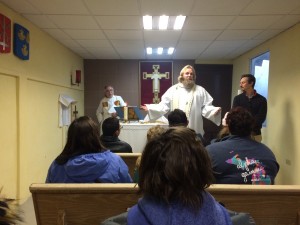 When asked about her work in Calcutta, Mother Teresa would often reply, “Come and see!”
When asked about her work in Calcutta, Mother Teresa would often reply, “Come and see!”
It’s an invitation to an encounter. An invitation to move beyond notions, ideas, theories — what remains abstract — and have an encounter with a real place, real people, in real time. This is what Christian and I hoped our trip to the Texas / Tamaulipas border would be for the eight participants and ourselves over the first week in January: a real encounter with people and places at the border that might have the power to transform.
When we arrived in Harlingen, Texas, we were welcomed into St. Alban’s Episcopal Church, given a place to sleep and some fresh-picked citrus to enjoy as we settled into the week ahead. The accommodations were basic, but new and nice. We slept on air mattresses in a large student lounge area that included a kitchen, right next to a gymnasium, and the bathrooms each had two roomy showers.
The morning after we arrived, we gathered in the chapel for some introductory words and opening prayer. We found out that our church backgrounds were quite varied, including Roman Catholic, Pentecostal, Reformed, and Episcopalian, and our faith engagements also at different levels–which made this an ecumenical and spiritual encounter just within our group!
 One of the great blessings of this trip was to have Aaron and Sarah along, a couple connected to Grace who were deeply passionate about Mexican history and immigration issues. Aaron teaches Mexican history at Hope College and Sarah is an attorney who has started a nonprofit immigration office here in Holland called Lighthouse Immigrant Advocates (and just received an award for her work from Holland’s Human Relations Commission). Both of them are fluent in Spanish and are talented educators, as well as full of good questions. They helped facilitate many of our encounters and greatly enriched our discussions.
One of the great blessings of this trip was to have Aaron and Sarah along, a couple connected to Grace who were deeply passionate about Mexican history and immigration issues. Aaron teaches Mexican history at Hope College and Sarah is an attorney who has started a nonprofit immigration office here in Holland called Lighthouse Immigrant Advocates (and just received an award for her work from Holland’s Human Relations Commission). Both of them are fluent in Spanish and are talented educators, as well as full of good questions. They helped facilitate many of our encounters and greatly enriched our discussions.
In particular, I remember Sarah passionately and thoughtfully questioning a second-career priest whose previous work was with the Department of Homeland Security, and our group processing after. I also remember Aaron on our night across the border in Matamoros, standing in the small chapel at the church where we stayed, translating Christian’s sermon into Spanish for the local congregants; and later, after tamales, carrying a conversation with the two priests who hosted us while he translated for our benefit.
Another of my favorite memories from the week was when I opened the door to the room we were staying and walked into a musical. Some of the girls were snuggled in their sleeping bags for warmth, singing their hearts out and laughing together. I was pleased at how our group came together as friends.
We had so many encounters, large and small, but the one that stood out for me personally was our tour of the contemporary art museum in Matamoros, Mexico. I encountered my personal bias that Matamoros would not have a museum that could compare to any of ours in art, culture, creativity, and presentation. However, I was brought to amazement and humility when in perfect English our tour guide led us through immaculate exhibits while explaining the nuances of Betsabee Romaro’s beautiful work featuring themes on immigrants. I saw–beauty and insight in the other, and unfair perception in myself–and I was changed.
 This week of encounter brought challenge and blessing, and not least of all new friendship. I believe we were all changed. Two of the Hope students are already making plans to go back and volunteer for a few weeks with the nuns come spring! And I pray that each of our transformations will continue; as we hear immigration issues discussed we now have names and faces and places to inform our ideas. And I pray that these will grow in us empathy, compassion, and temperance as we speak with confidence and humility about our border, about immigration, and about a better world.
This week of encounter brought challenge and blessing, and not least of all new friendship. I believe we were all changed. Two of the Hope students are already making plans to go back and volunteer for a few weeks with the nuns come spring! And I pray that each of our transformations will continue; as we hear immigration issues discussed we now have names and faces and places to inform our ideas. And I pray that these will grow in us empathy, compassion, and temperance as we speak with confidence and humility about our border, about immigration, and about a better world.
~Andrew Spidahl, Hope & Grace: College and 20/30s Ministry Co-Chair
